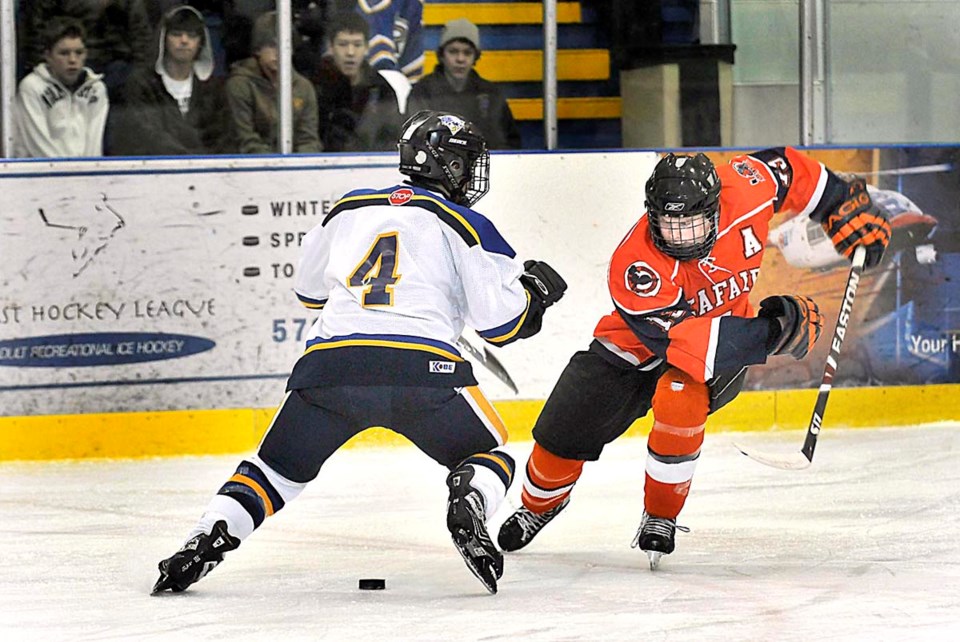A new era for minor hockey could be on the horizon if a purposed merger between Richmond Minor and Seafair succeeds.
It’s the province’s most unique hockey rivalry — two non-profit associations co-existing in the same territorial boundary.
Today, B.C. Hockey or the regional governing body — Pacific Coast Amateur — wouldn’t even approve such an arrangement that transpired when Seafair went from a private club to a public-offered program in the early 1990s.
In the years that followed, Seafair was in the shadow of its much larger neighbour. Top talent typically left to play for Richmond Minor’s older “AAA” rep teams.
That all changed when a strong group coming through Seafair decided to stay put. Other younger teams followed and Seafair became a powerhouse at the smaller “AA” level, regularly contending and winning provincial titles. As registration continued to grow, the rep program evolved to the point where it was on par with the province’s largest associations.
The Seafair and Richmond Minor’s top teams were now routinely facing each other. The rivalry was no greater than the 2008 Richmond Midget International “AAA” championship game which saw Seafair defeat Richmond Minor in front of a near capacity crowd at Minoru Arena.
Today, both associations are dealing with minor hockey’s ever-changing landscape.
School academies are now an option for rep players and B.C. Hockey is expected to expand its regional league to include Bantam age players, potentially thinning the local talent pool even further.
These developments have helped take merger discussions where they have never gone before. Progress has been made to the point where members will be voting on it for the very first time.
Presidents Carolyn Hart (Richmond Minor) and Nigel Shackles (Seafair) began discussing the idea about a year ago. There was a window of opportunity coming where both associations’ services contracts for professional coaching were expiring at the same time.
The two agreed upon forming a seven-member merger committee (four from Richmond Minor and three from Seafair) that began meeting regularly in September. Since then, their ideas have been brought forward at various information meetings, hosted separately by both associations.
The next step is adopting a new constitution, as required by the B.C. Societies Act, at each of the associations upcoming AGMs. That would pave the way for a membership vote. It will take 66 per cent approval for the merger to go through and the new organization would take over in time for the 2018-19 season.
Shackles is remarkably in his 20th year serving on the Seafair executive and recently agreed to carry on for a sixth term as president next season. Hart was a one-time Seafair volunteer who is now overseeing Richmond Minor. The pair have the associations working close together and creating additional “bridges” to enhance the relationship even if the merger doesn’t succeed.
“Every year, people say the merger will happen but not on their watch or their time. I just keep thinking why not now?” said Shackles. “If people think that then why not discuss the pros and cons of making it a reality. You have to have that dialogue between the two associations to start with and that’s where I approached it from.”
“Nigel and I are on good terms,” agreed Hart. “I don’t think it was too difficult to begin the conversation. I also think we have excellent people in our committees who are committed to it.”

The merger attempt is not out of desperation from either side.
Seafair is now the larger of the two associations with over 800 players, but both are healthy and could continue on business as usual.
Together, they would form the largest association in Pacific Coast Amateur — an estimated 1,300 players.
“If we don’t merge life goes on,” said Shackles. It’s just minor hockey. Both are doing well. No one is in desperate need that they have to merge. We just think it’s better for the community.
“This is a chance to take something and create the best association in the province. “Not really success-wise, but best run, forward thinking and most aggressive. (The rivalry) does keep us on our toes, but we spend so much time competing. What we can create together is better than just sum of parts.”
When there is animosity between players from the respective associations, it’s typically at the “C” level these days as the majority of rep teams play at different tiers and don’t see each other.
“If the objective for your child to play sports is social, making friends and working together by being part of a team, then you can make the argument for a merged association,” said Hart. “We see situations at school where you have classrooms with some members from each association, and it can get unhealthy in some circumstances, if one is outnumbered, so to speak.
“If your objective is for your child to excel at your sport and to play on the best possible team, then merger is the right way to go. They are going to be playing with more athletes who have similar skills. It will be a stronger rep program, for sure.”

Both agree there would be a potential loss in annual Community Gaming Grants with each association currently receiving separate funding.
The estimated loss in revenue is 10 per cent. It could be overcome with more corporate sponsorship.
Hart suggests the new association could be eligible for a higher regional grant since there will be some programs offered to players outside of Richmond.
Shackles also understands there are those who would prefer to see the merger attempt fail and the minor hockey tradition of two associations in Richmond continue.
“There is the emotional-side argument to it — the desire to see the name and history carry on, whether it’s Seafair or Richmond Minor,” he said. “I bleed blue and orange (Seafair colours) more than anyone can possibly imagine. But this community can’t be about what I need and what my emotions are. It’s got to be what is best for as many kids as possible. The only way to get past that is to take the emotional argument off the table for the vote and to get down to the philosophical question.”
That’s why this merger attempt is not trying to answer every question that comes with a potential partnership, unlike the previous try two years ago that failed to gain any momentum.
Instead, they will be addressed by the new executive, with each of the association’s rich history being factored in.
The greatest challenge is expected to be getting enough members to vote.
Seafair recently ran an informal survey that attracted 400 votes and two-thirds were in favour of merging. Another third agreed to it under certain conditions. Richmond Minor is expected to do the same shortly and produce similar results.
Information meetings were not well-attended by members from either group. The vote does not require a minimum turnout percentage to be ratified.
“The majority of the people in our association are soft supporters of it. Whether they come out that night to vote is a different question,” added Shackles. “I know the people who are totally against the idea will, also the group that wanted this to happen last week. It’s that group in the middle. Do they care enough or (are they) just happy to take their kid to the rink, regardless of what jersey they are wearing?”
That’s why Hart has even taken the time to pull parents away from games at the RIC in recent weeks to provide impromptu information meetings on the merger, especially at the younger levels.
“It’s about getting these parents informed and having an opinion,” said Hart. “Nigel’s son is now finished hockey and my son has one more year. Neither child will be involved (in the new association) Reality is, it should be the parents of young children who should be determining this outcome.”
Rivalry ignited by Seafair players staying put
His family was immersed in the Richmond Minor/Seafair rivalry for many years. Now, Derek Chichak suggests the timing is right for the associations to come together.
The lifelong Richmond resident served on the Seafair executive for seven years and also has extensive coaching experience with the organization — spending 10 seasons with its grassroots introduction program and several more guiding rep teams.
Chichak’s son, Andrew, was part of a very strong group coming through the association that would break the “unwritten rule” and change the path of local talent.
Instead of crossing over to play for Richmond Minor’s rep program for Pee Wee and beyond, the team decided to stay together and the rivalry was about to take off.
“You went to Seafair up to Atom and then went to Richmond Minor to play rep AAA. That’s just the way it was,” recalled Chichak. “When Seafair moved to the (Richmond) Ice Centre (then president) Frank Claassen asked why they were paying full price for ice time. He lobbied the city and got (subsidized ice). Now, suddenly, we were on the same playing field as Richmond Minor.
“Back then, Dave McLellan had been brought in as our first professional coach. He ran these popular Friday night sessions that all the kids went to. When Andrew’s group had finished Atom, many of us didn’t want to leave Seafair.”
It took paying McLellan to coach the team for all the boys to stay. It would be the start of Seafair becoming a force at the older rep levels and it took advantage of competing at a lower AA tier, thanks to being a smaller association.
Seafair’s rep teams were eventually on par or surpassing Richmond Minor’s top squads. The rivalry hit a fevered pitch in 2008 when the Islanders defeated the host Blues in the AAA final of the Richmond International before nearly 1,000 spectators.
“That was unbelievable,” smiled Chichak, who was the winning coach that day. “It was almost surreal. I never expected the game to be that big. They had finally let us in the tournament, and I think it was pressure from within its own people to do it. We ended up winning it back-to-back years.”
Chichak’s success earned him a stint coaching at the junior B level with the Delta Ice Hawks. He then, ironically, coached Richmond Minor’s top Midget team for the 2015-16 campaign, before stepping away entirely last season.
The rivalry has been a big part of his coaching career, but now Chichak says a merger of the two associations would probably be best for everyone.
“Right now, minor hockey is really getting watered down. Kids now have academies, major midget, junior B and soon (Bantam) zone teams. It’s getting harder and harder to compete at that level,” he said.
“Sure, you can stack one team (at Seafair or Richmond Minor). But you have to look at the logistics that take place to always do that and the emotional stress that two associations cause. It really does take away from focusing on what you have to do to run the best program for the kids.
“There’s not two city councils running Richmond. So, why not have just one and be able to cover all the bases with it? It’s hard enough finding volunteers these days.”



